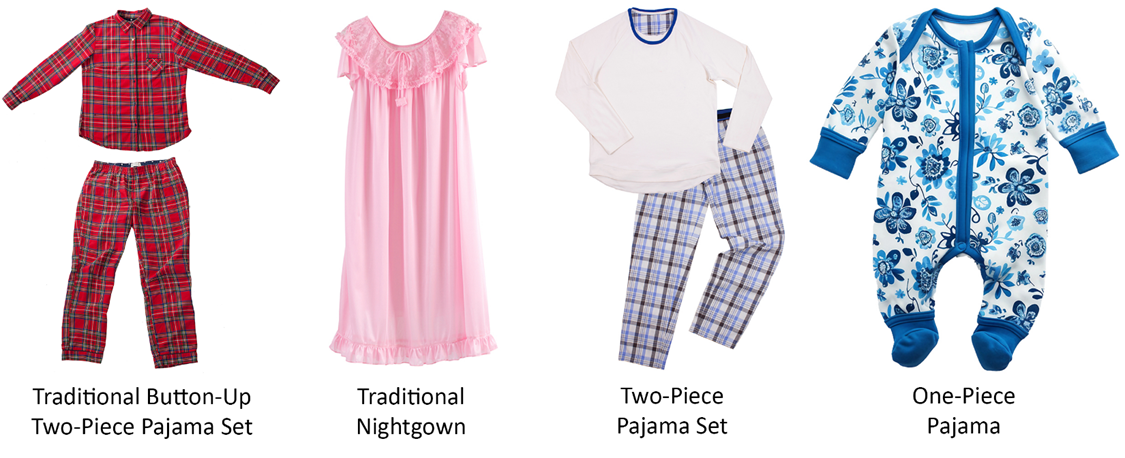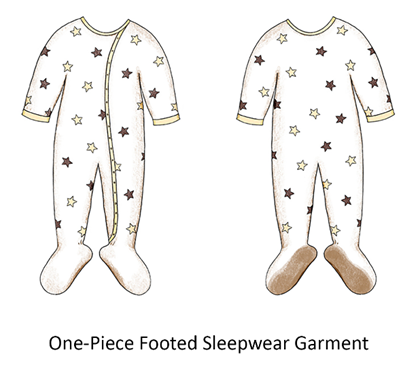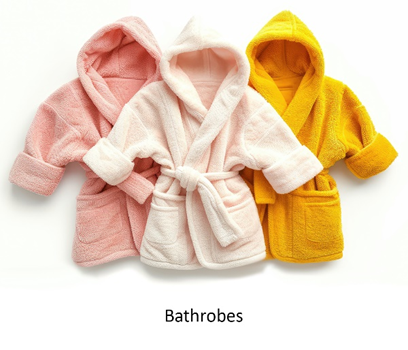There are flammability requirements for children’s sleepwear to protect children from burns. It is required that the children’s sleepwear is flame-resistant and can self-extinguish. 16 C.F.R. part 1615 (Sizes 0 through 6X) & 16 C.F.R. part 1616 (Sizes 7 through 14) were created in response to reports of children burning themselves from sources such as matches, lighters, candles, ranges, stoves, space heaters, and fireplaces. These incidents occurred at times when children were wearing pajamas – at night and in the early mornings, normally unsupervised.
The requirements for the flammability of children’s sleepwear are codified at 16 C.F.R. part 1615 (Sizes 0 through 6X) & 16 C.F.R. part 1616 (Sizes 7 through 14). The two standards contain mostly the same requirements, with the main difference being the sizes they cover.
For more information on the Flammable Fabrics Act (FFA), visit our FFA business guidance page.
Children’s sleepwear that is subject to 16 C.F.R. parts 1615 and 1616 is any product of wearing apparel (sizes 0 through 14) such as nightgowns, pajamas, robes, or similar or related items, such as loungewear, intended to be worn primarily for sleeping or activities related to sleeping (e.g., bedtime prep, story time, lounging), except:
- Diapers and Underwear
- Infant Garments
- Tight-fitting Garments
Diapers, underwear, “infant garments” as defined in 16 C.F.R. § 1615.1(c), and “tight-fitting garments” as defined in 16 C.F.R. §§ 1615.1(o) and 1616.2(m) are excepted from children’s sleepwear flammability testing under 16 C.F.R. parts 1615 and 1616 and are instead subject to the flammability testing requirements of 16 CFR part 1610. For information about infant garments and tight-fitting sleepwear garments, view the FAQs here.
CPSC considers many factors when determining if a garment is considered children’s sleepwear, including:
- The construction and style of the garment
- Suitability for sleeping or activities related to sleeping
- The likelihood that the garment is used for sleeping or activities related to sleeping
- The manner in which the product is distributed, promoted, and merchandised
- Fabric features – fiber content, weight, print motifs, softness, etc.
- How the fabric or a comparable fabric has been used to manufacture other children’s garments
- Current trends
Please note that this is not a comprehensive list. A particular garment may meet the definition of “children’s sleepwear” even if the above factors are not present.
Photos of Examples of Common Sleepwear Garments:

Diapers, underwear, “infant garments” as defined in 16 C.F.R. § 1615.1(c), and “tight-fitting garments” as defined in 16 C.F.R. §§ 1615.1(o) and 1616.2(m) are excepted from children’s sleepwear flammability testing.
For information about infant garments and tight-fitting sleepwear garments, view the FAQs here.
One-piece children’s garments are not always considered children’s sleepwear.
In general, CPSC staff considers one-piece footed/non-footed garments with front or back openings that extend to the waist or longer to be items of children’s sleepwear. However, this is not the only factor that we take into consideration and may need to be evaluated on a case-by-case basis.
See “What garments are considered children's sleepwear?” on this FAQ page.

CPSC staff considers children’s “loungewear” (or other similar garments marketed as comfort wear) as garments worn primarily for sleep-related activities. Therefore, “loungewear” must comply with the children’s sleepwear standards. See CPSC’s Sleepwear and Loungewear Position Letter.
The following items are generally not considered “loungewear” in most circumstances, and would likely be considered daywear:
- Athletic Leggings
- Crewnecks
- Sweatshirts
- Sweatpants
- Other “athleisure” garments
However, CPSC staff looks at more factors than just style and construction. See “What garments are considered children's sleepwear?” on this FAQ page.

Generally, children’s robes worn at home, including plush and bathrobes, are subject to the children’s sleepwear standards.
Children’s robes used in activities related to sleeping are generally knee length or longer; whereas children’s cover-ups used at the beach or pool are generally shorter than knee length, in addition, beach/pool cover-ups use absorbent fabric. Beach and pool cover-ups shortened to above the knee are not to be considered as children’s sleepwear provided they are not promoted, advertised, merchandised or labeled as sleepwear.

The intended use, design, and marketing of the baby wearable sleep blankets/sleeping bags are critical factors when evaluating these products. If the baby is intended to be dressed in sleepwear before being put into the sleeping bag, CPSC staff considers the sleeping bag to be general wearing apparel that is subject to 16 C.F.R. part 1610. If the baby is not intended to be dressed in sleepwear other than a diaper before being put into the sleeping bag, CPSC staff considers the sleeping bag to be sleepwear that is subject to 16 C.F.R. part 1615 (sizes 0 through 6X).
Any marketing and advertising must be clear regarding the intended use of the baby sleeping bag.

Children’s sleepwear garments that are in-scope of 16 C.F.R. parts 1615 and 1616 must pass the flammability testing specified in the standards. This includes Fabric Production Unit (FPU) testing and Garment Production Unit (GPU) testing.
FPU testing includes testing pre-production fabric. Each FPU number can apply to a maximum of 5,000 yards of finished fabric. Once the fabric is shown to pass flammability testing, GPU testing occurs.
GPU testing includes prototype testing and production testing. Prototype testing includes testing pre-production seams and trim, and production testing includes post-production seams. Each GPU number can apply to a maximum of 500 dozen finished garments.
For a more detailed explanation on the testing requirements, please see CPSC’s Laboratory Test Manual for 16 C.F.R. parts 1615 and 1616.
Children’s sleepwear subject to 16 C.F.R. parts 1615 and 1616 are required to have the following labeling:
- Unit Identification: A permanent label with a unit identification (number, letter, date, or combination) sufficient to identify and relate to the Fabric Production Unit (FPU) or Garment Production Unit (GPU) of which the item is a part. The letters “GPU” and “FPU” may be used but are not required. See 16 C.F.R. § 1615.31(b)(8).
- Flame Resistance Chemical Care Label: A permanent label with precautionary instructions on all items of children’s sleepwear to protect the item from agent or treatments which are known to cause deterioration of their flame resistance. See 16 C.F.R. § 1615.5(a).
- Tracking Label: Children’s products must bear distinguishing, permanent marks on the product and any packaging that allow consumers to ascertain the identity of the manufacturer or private labeler, date and place of manufacture, detailed information on the manufacturing process (i.e., batch or run number), and the specific source of the product (e.g., address of the specific manufacturing plant).
- A Federal Trade Commission (FTC)’s Registration Number (RN) can be used in the place of a Manufacturer, Importer, or Private Labeler name.
- A Garment Production Unit (GPU) or Fabric Production Unit (FPU) number can meet the requirement as a batch or run number.
CPSC staff is aware that children’s sleepwear garments manufactured using certain untreated fibers typically fail children’s sleepwear flammability testing under 16 C.F.R. parts 1615 and 1616, including 100% Cotton, 100% Silk, 100% Rayon, and 100% Modal.
If you were planning on making children’s sleepwear garments with these fabrics, we recommend using different fabrics or looking into implementing the integration of flame-resistant fibers (such as Modacrylic, to give just one example). Alternatively, if you meet the measurement, tagging, sizing, and labeling criteria for an infant garment at 16 C.F.R. § 1615.1(c) or tight-fitting sleepwear garment at 16 C.F.R. §§ 1615.1(o) or 1616.2(m), they are subject to the different flammability requirements of 16 C.F.R. part 1610, and it may be possible that these fabrics comply. For information about infant garments and tight-fitting sleepwear garments, view the FAQs here.
Different colors or different print patterns (not both) of the same fabric may be included in a single Fabric Production Unit (FPU) or Garment Production Unit (GPU), as long as the colors or print patterns demonstrate char lengths that are not significantly different from each other. This can be determined by previous testing of at least three samples from each color or print pattern to be included in the Unit. See 16 CFR §§ 1615.4(b)(2) and 1616.4(a)(2).
Garments with different trim and findings may be included in a single GPU if the other garment characteristics are identical except for size, color, and print pattern. See 16 CFR §§ 1615.4(b)(3) and 1616.4(a)(3).
There are general requirements for products primarily designed or intended for children 12 years of age or younger:
- Lead in paint and similar surface coatings: Children’s products must not bear paint and/or similar surface coatings that contain more than 0.009 percent (90 ppm) lead.
- Examples include painted component parts (e.g., buttons, zippers, snaps), printing processes that use a liquid or semi-liquid surface coating that hardens (e.g., screen printing)
- Total lead content: Children’s products must not contain greater than 100 ppm (0.01 percent) of total lead content in any accessible component part. 16 C.F.R. § 1500.87 addresses determination of accessibility for the purposes of the total lead content rule.
- Examples include component parts (e.g., buttons, zippers, snaps), heat transfer vinyl, metallic threads/fibers
- CPSC made a determination under 16 C.F.R. § 1500.91(d)(7) that textiles (excluding those that contain treatments or applications that do not consist entirely of dyes) are not required to be tested for total lead content. CPSC made similar determinations for plant-derived and animal derived materials at 16 C.F.R. § 1500.91(d)(8) and certain metals and alloys at 16 C.F.R. § 1500.91(e).
- Phthalates: Children’s toys and child care articles as defined per 16 C.F.R. § 1307.2 must not contain greater than 0.1 percent (1000 ppm) of any regulated phthalate in any accessible component part. 16 C.F.R. § 1307.3 lists the regulated phthalates, and 16 C.F.R. part 1199 addresses determination of accessibility for the purposes of the phthalate rule.
- Examples include plasticized component parts, certain screen-printing inks, plastic skid-stoppers/no skid grippers on the bottom of one-piece pajamas
- Third-party testing: Children’s products must be tested for compliance to applicable safety rules by a third-party, CPSC-accepted laboratory.
- Certification: Domestic manufacturers or importers of children’s products must generate a Children’s Product Certificate (CPC) certifying compliance to the applicable safety rules and ensures that a CPC accompanies the distribution of the product.
- Tracking label: Children’s products must bear distinguishing, permanent marks on the product and any packaging that allow consumers to ascertain the identity of the manufacturer or private labeler, date and place of manufacture, detailed information on the manufacturing process (i.e., batch or run number), and the specific source of the product (e.g., address of the specific manufacturing plant).
- A Federal Trade Commission (FTC)’s Registration Number (RN) can be used in the place of a Manufacturer, Importer, or Private Labeler name.
- A Garment Production Unit (GPU) or Fabric Production Unit (FPU) number can meet the requirement as a batch or run number.
Apparel may be subject to additional regulatory requirements by the Federal Trade Commission (FTC) and, for imported goods, by U.S. Customs and Border Protection (CBP).
A few helpful documents discussing these requirements can be found at:
- FTC: Threading Your Way Through the Labeling Requirements Under the Textile and Wool Acts (Registered Identification Numbers)
- FTC: Clothes Captioning – Complying with the Care Labeling Rule
- CBP: What Every Member of the Trade Community Should Know About Textile & Apparel Rules of Origin
- CBP: Basic Importing and Exporting
Please contact those agencies with any questions you may have on their requirements.
